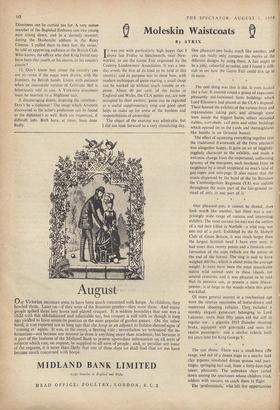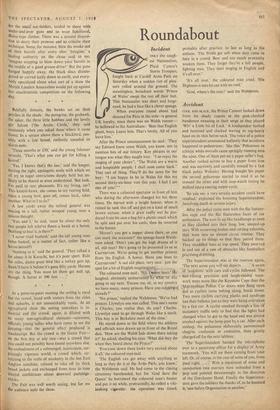Moleskin Waistcoats
By STRIX 'drove was not with particularly high hopes that I 'drove last Friday to Stetchworth, near New- market, to see the Game Fair organised by the Country Landowners' Association. It was a two- day event, the first of its kind to be held in this country; and its purpose was to show how, with modern techniques of game-rearing, a small shoot can be worked up without much trouble or ex- pense. About 40 per cent, of the farms in England and Wales, the CLA points out, are now occupied by their owners; 'game can be regarded as a useful supplImentary crop and good sport helps to make up for some of the burdens and responsibilities of ownership.'
The object of the exercise was admirable, but I did not look forward to a very stimulating day. One pheasant-pen looks much like another, and you can really Only compare the merits of the different designs by using them. A fair ought to be a jolly, colourful occasion, and I found it diffi- cult to see how the Game Fair could live up to its name.
' * The odd thing was that it did. It even looked like a fair. It centred round a group of capacious, pleasantly old-fashioned farm buildings which Lord Ellesmere had placed at the CLA's disposal. These housed the exhibits of the various firms and organisations taking part, and although some were inside the biggest barns, others occupied stables, cart-sheds, calf-pens and other buildings which opened on to the yards and thoroughfares like booths in an Oriental bazaar.
The effect of squeezing everything together into the traditional fratnework of the farm precincts was altogether happy. It gave an air of higgledy- piggledy character to the exhibits, and made a welcome change from the impersonal, suffocating tyranny of the marquees, each insulated from its neighbour by a small reciprocal no man's land of guy-ropes and tent-pegs. It also meant that the music dispensed by the band of the 1st Battalion the Cambridgeshire Regiment (TA) was audible throughout the main part of the fair-ground in- stead of only in one part of it.
* * *
One pheasant-pen, it cannot be denied, does look much like another, but there was a sur- prisingly wide range of curious and interesting exhibits. The most curious (to me) was the antlers of a red deer killed in Norfolk—a wild stag, not one out of a park. Exhibited by the St. Hubert Club of Great Britain, it was much larger than the largest Scottish head I have ever seen; it had more than twenty points and a freakish con- formation of the cups (which are the points at the end of the horns). The stag is said to have weighed 400 lbs., which is about twice the average weight. It must have been the most remarkable native wild animal seen in these islands for several centuries, and it was pleasant to be told that its putative son, at present a mere fifteen- pointer, is at large in the woods where this giant was killed.
Of more general interest in a mechanised age were the veteran specimens of horse-drawn and motorised shooting vehicles. They,, included a sturdily elegant game-cart belonging to Lord Leicester, more than fifty years old but still in regular use : a gigantic 1913 Daimler shooting brake, equipped with gun-racks and seats for twelve passengers : and a similar vehicle built ten years later for King George V.
* * *
The sun shone. There was a small-bore rifle range, and out of a dozen traps in a nearby field clay pigeons simulated driven grouse and part- ridges, springing teal and, from a forty-foot-high tower, pheasants. The unbroken clays curled down among the spectators whose children tried, seldom with success, to catch them in flight.
The 'professionals,' who left few opportunities for the small out-fielders, tended to shoot with under-and-over guns and to wear functional, Risley-type clothes. There was a natural disposi- tion to decry their prowess and to criticise their technique. Some, for instance, blew the smoke out of their barrels after every shot. 'Imagine,' a leading authority on the chase said to me, `imagine stopping to blow down your barrels in the middle of a good grouse-drive!' But the guns banged happily away, the black discs disinte- grated or curved lazily down to earth, and every- body speculated about what sort of a show the Muzzle Loaders Association would put up against less anachronistic competition on the following day.
Balefully demure, the hawks sat on their Perches in the shade : the peregrine, the goshawk, the saker, the three little hobbies and the lovely gyr falcon ('the Arctic , Circle,' they said cautiously when you asked them-where it came from). In a spruce above, them a blackbird, pos- sibly with a late brood, endlessly sounded its alarm-note.
'Three months or £50,' said the young falconer severely. 'That's what you can get for killing a kestrel.'
'Yes, I knows that's the law,' said the keeper, smiling the tight, apologetic smile with which we all try to sugar convictions deeply held but un- likely to be shared or even understood. 'But look. I'm paid to rear pheasants. It's my living, see? This kestrel-hawk, she comes to my rearing field, takes a young bird, goes off, comes back, takes another. What'm I to do?'
A few yards away the retired general was voicing to a tall, rather stooped young man a solemn thought.
'You and I,' he said, 'must be about the only two people left who've flown a hawk at a heron. Nothing to beat it, is there?'
'I never tried bustard,' .said the tall young man (who looked, as a matter of fact, rather like a heron himself).
'Nothing in it,' said the general. 'They talked a lot about it in Karachi, but it's poor sport. Ride for miles, dadm great bird like a turkey gets up, hawk'll have it before it's gone fifty yards. Herons are the thing. You must let them get well up, though. A heron at 500 feet . .
At a point-to-point meeting the setting is rural but the crowd, laced with visitors from the cities and suburbs, is not unmistakably rustic. At an agricultural show the setting nowadays is in- dustrial and the crowd, again, is diluted with so many non-agricultural elements—salesmen, officials, young ladies who have come to see the lumping—that the general effect produced is nondescript. But the crowd at the Game Fair— on the first day at any rate—Was a crowd that You could not possibly have found anywhere else, the embodiment of a submerged, inarticulate, sur- prisingly vigorous world, a crowd which, cir- culating to the rattle. of musketry in the hot East Anglian sunshine, refused to take off its thick tweed jackets and exchanged from time to time doleful confidences about drowned .partridge- chicks.
The Fair was well worth seeing; but for me the audience stole the show.































 Previous page
Previous page